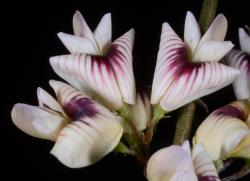- Taxon
- Gallery
- = Carmichaelia gracilis J.B.Armstr., Trans. & Proc. New Zealand Inst. 13: 336 (1880 [1881])
- = Carmichaelia kirkii var. strigosa G.Simpson, Trans. Roy. Soc. New Zealand 75: 267 (1945)
Liana, up to 1-3 m tall, climbing, scrambling, and sprawling, or rarely a bushy shrub without support. Branches up to 40 mm diameter, ascending and spreading. Cladodes 70- 350(-420) × 1.7—3 mm, spreading and often divaricate, linear, striate, terete, green, green-bronze, or bronze, hairy or glabrous, apex obtuse; leaf nodes 4—12. Leaves 1—5-foliolate, present on seedlings and usually on inner parts of adult plants, terminal leaflet larger; lamina 4.5—8 × 2.5-6 mm, obovate to broad-elliptic, fleshy, green or bronze-green, adaxial surface glabrous, abaxial surface glabrous or with a few scattered hairs, apex emarginate, base cuneate; petiole 6-25 mm long, glabrous or hairy, green or brown-green; petiolule 0.5-0.9 mm long, glabrous, light green. Leaves on cladodes reduced to scales, < 0.6 mm long, broad-triangular, glabrous, apex subacute. Stipules 0.7-1 × 0.6-0.8 mm, free, triangular, adaxial surface glabrous, abaxial surface with few scattered hairs, apex subacute, margin hairy. Inflorescence a raceme, 1—2(—3) per node, each with (1—)2—5 flowers. Peduncle 2-6 mm long, glabrous to densely hairy, green or red. Bracts 0.5-1.2 mm long, triangular, sparsely hairy, apex obtuse or subacute, margin hairy. Pedicel 2.5—4 mm long, glabrous to densely hairy, green or red. Bracteoles c. 0.5 × c. 0.3 mm, narrow-triangular, on receptacle or lower part of pedicel, green or red, apex obtuse to subacute, margin hairy. Calyx 4—5 × c. 2 mm, campanulate, green and occasionally flushed red, outer surface glabrous or hairy. Calyx lobes 1.5- 2.5 mm long, narrow-triangular, green and usually flushed red, inner surface densely hairy, apex acute; two ventral lobes appressed to base of standard, three dorsal lobes spreading away from keel. Standard 8— 9 × 8.5—12 mm, orbicular or broad-obovate, patent, positioned in central part of keel, weakly keeled, margins recurved, apex emarginate or occasionally mucronulate; central part of inner surface red-purple, margins white, sometimes purple-veined; outer surface white with a darkened central part; claw 2— 3 mm long, green. Wings 6—8 × 2.5—3.5 mm, oblong, shorter than keel, apex obtuse; outer surface white, proximal part pale green; inner surface sometimes purple-veined; auricle 1—1.5 mm long, triangular, white or flushed green; claw 2-2.5 mm long, pale green. Keel (Fig. 2A) 8-9 × 3—3.5 mm, apex obtuse; distal part of inner surface red-purple, proximal part white or pale green; auricle c. 1 mm long, triangular, white or pale green; claw 3—4 mm long, pale green. Stamens 6.5-8.5 mm long; dorsal filaments connate for c. ¾ of length, outer stamens free for c. 2 mm. Pistil 8.5—10 mm long, exserted beyond stamens; style bearded on upper surface, ovary glabrous; ovules 8-10. Pods 12-18 × 4-5.8 mm, broad-elliptic, laterally compressed, spreading, dark brown, grey-brown, or yellow-brown, both valves partially dehiscent and remaining attached to lower replum; beak 3-6 mm long, on adaxial suture or in central apical position, stout, pungent-tipped. Seeds 2—3.5 × 1.7—2.5 mm, broad-elliptic, reniform, oblong-reniform or rounded, 2-5 per pod, off-white with black or dark purple mottling. Chromosome number In - 32 (Slade 1953). FL Nov-Jan, FT Jan-Jun.
[Reproduced from Heenan (1996, New Zealand J. Bot. 34: 157-177) with permission from The Royal Society of New Zealand.]




